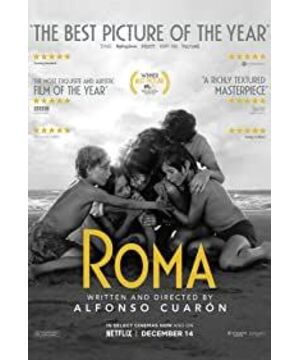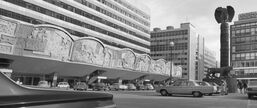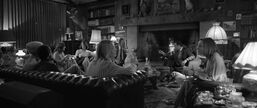Text | Li Zijin
After "Roma" won the highest gold Lion Award at the Venice Film Festival, it was listed as the first place in the top ten films of the year by magazines such as "Time", "Rolling Stone", "Vanity Fair" in the United States, and "Sight and Sound" in the United Kingdom.
Vanity Fair said of its selection: "It has reached the limit of immersion in a 2D film, and it is an epic of hard times that is exhilarating, exhausting, and heartbreaking."
Its director , Alfonso Cuaron , is one of the "Three Mexican Heroes" with a brilliant record at the international A-category film festival, and any work ("Harry Potter 3: Prisoner of Azkaban", "Children of Men") ""Gravity"...) is enough to leave a name in film history.
Roma, a film about the unusual interactions between a middle-class family (the master) and their nanny (the servant) in Mexico City in the 1970s, conveys an emotional relationship that transcends class antagonisms and "The unspeakable bond between people" - love.
The film is also a love letter from director Cuaron to his wet nurse Libo . This wet nurse was pregnant out of wedlock when Caron was a child. She has experienced the turbulence of the times and the joys and sorrows of life. She has taken care of the Caron family since she was in her twenties and has never left.
When Cuaron planned to make the film, he said to his brother Carlos:
"I wanted to make this movie. Because I knew I had to make a movie like this in my life, even if there was no audience."
He waited 12 years and did a lot of behind-the-scenes work to make this film.
Ninety percent of the scenes in the film come from Cuarón’s memory, some direct, some devious, but they are all about the era of Cuarón that was shaped, or the era that shaped Mexico, the beginning of a long period of change in Mexico.
Watching this movie, it has to be said that it is the color issue of the whole film.
The whole film is in black and white. It can be said that it is the best black and white film I have seen in recent years!
The use of black and white tones draws the audience away from the excessive concentration of colors;
At the same time, the black and white tones also symbolize the memory of the past, which can better highlight the purity of the emotions and enhance the subtle expressive power of the picture .
In addition to this, the black and white lens enhances the contrast, giving the lens another pristine and natural aesthetic.
Black and white tones, more accentuate the nuanced expressions of the characters
The first scene of the movie must have impressed many people: the sound of water washing the ground became clearer and clearer, and after the floor was washed, the plane reflected in the water.
Those were memories of Cuaron's childhood, his family living in the Roma district, below the flight path to Mexico City airport. So in his memory, there are always planes flying overhead.
The camera moves with the ground to the person washing the floor, Cleo, the protagonist of the film.
In the first part of the film, the life and times background of the nanny Cleo and the employer Sophia are introduced.
Cleo is always busy with various jobs at home; Ying Feiya, seems to have a happy family.
From the mouths of the children, it is known that this is an uneasy time:
"Just now there was a kid who was throwing water balloons at a passing car, and then an army jeep drove by, he threw a balloon on the car, and the soldiers in the car got irritated and got out of the car and shot him , he hit him on the head, he died."
In this turbulent era, everyone has no time to take care of others, and the fate of the little people only flashes in the mouths of children.
Subsequently, Antonio abandoned Sofia and four children under the pretext of work;
After Cleo's boyfriend Fermin learned that Cleo was pregnant, he also left Cleo on the pretext of going to the toilet.
How will the lives of two abandoned women change?
Through events such as picnics in the forest, forest fires, outdoor dinners, hospital births, student sports, and beach rescues, the director gradually brought the two characters out of the shadow of being abandoned.
In this process, a large number of comparison methods are used.
The biggest contrast is the turbulence of the big era and the contrast of the fate of the little people.
There was a crackdown on the march outside the window, and Cleo's amniotic fluid broke in the window; in such an era, she had no time to take care of the riots, and of course she only cared about the child in her womb.
A political event here was the 1971 repression of the marches that took place when Luis Echeverria Alvarez was president of Mexico.
Cuaron did not focus on describing this scene when shooting, which has also become a point that many domestic fans complained about. I feel that Cuaron has no political sensitivity, and the film is not infectious and realistic.
In fact, if this parade is portrayed as a key point, it will be counterproductive and distracting.
"Roma" belongs to Cleo. For her, living the life in front of her is the key point. All of this has nothing to do with her. Pregnancy out of wedlock is far greater than the trouble brought to her by the turmoil. much more.
There are also contrasts and metaphors in these shots of the film:
When Antonio and Ying Fia parted, they contrasted with the lively band.
When Sophia's family returns from a trip, the raucous band reappears.
There's always shit all over the floor, just like life.
Sofia's release on Antonio's departure Then, the comparison between the replacement car and the previous big car.
Cars are like life, and big cars, like Antonio, need to be constantly adjusted to adapt to their lives; and in the end, the small car is replaced, which is obviously more suitable for their lives.
Sophia informs the child of the divorce, and Cleo accepts the fact of the stillbirth in contrast to the hilarious wedding next to him.
The contrast between the last picture of the film - "Heaven" and the first picture - "Earth" also symbolizes "beginning with 'Earth' and ending with 'Heaven'".
The emotions of the whole film reached a climax in the scene of saving people on the beach.
Cleo, who can't swim, is desperate to find the child in the storm. At this moment, she seems to want to find the child she lost.
After rescuing the child, they hugged and cried. At this moment, Cleo seemed to finally be relieved of the stillbirth.
The Sophia family also expressed their love for Cleo: "We love you so much, Cleo, don't we."
On the beach, the sun shines on their skin, the family hugs each other, this is the warmest moment!
"Roma" is a letter from Cuaron to the past, and it is also a sad song for women!
View more about Roma reviews











